
The PADD is one of the most commonly-used props on Star Trek. Over the years the production
team has made dozens of different versions.
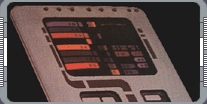 The Personal Access Display Device, or PADD, is one of the most widely-used props on Star Trek. Some
claim that it dates back to the original series, where it was seen as a black, wedge-shaped computer
clipboard, with red and white blinking lights and a 'magic slate' writing surface. This particular prop
appeared again in Star Trek: The Motion Picture as a sleeker gray unit, with about 10 small lights and no
visible writing surface. It may also have been seen as the malfunctioning device in which Kirk tried to
record his log in Star Trek V: The Final Frontier. Since these units were primarily for data storage and
retrieval, however, they should only be considered predecessors
The Personal Access Display Device, or PADD, is one of the most widely-used props on Star Trek. Some
claim that it dates back to the original series, where it was seen as a black, wedge-shaped computer
clipboard, with red and white blinking lights and a 'magic slate' writing surface. This particular prop
appeared again in Star Trek: The Motion Picture as a sleeker gray unit, with about 10 small lights and no
visible writing surface. It may also have been seen as the malfunctioning device in which Kirk tried to
record his log in Star Trek V: The Final Frontier. Since these units were primarily for data storage and
retrieval, however, they should only be considered predecessors
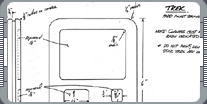 to the PADD, rather than earlier versions of it. The modern PADD first appeared in Season One of Star
Trek: The Next Generation (circa 2364). Designed by Rick Sternbach, the standard small PADD measured 4"
x 6" x 1/2". It's thickness varied by up to 3/4" to allow for lights, batteries, etc. PADDs are used
for a variety of functions. Primarily, they are used by Starfleet personnel to store, retrieve, and
manipulate information, and communicate that information with others. As we have seen in episodes of TNG
and Deep Space Nine, PADDs have also been used by students for homework and by others for a variety of
leisure activities, such as reading literature or playing games. Think of it as a very, very small
laptop computer!
to the PADD, rather than earlier versions of it. The modern PADD first appeared in Season One of Star
Trek: The Next Generation (circa 2364). Designed by Rick Sternbach, the standard small PADD measured 4"
x 6" x 1/2". It's thickness varied by up to 3/4" to allow for lights, batteries, etc. PADDs are used
for a variety of functions. Primarily, they are used by Starfleet personnel to store, retrieve, and
manipulate information, and communicate that information with others. As we have seen in episodes of TNG
and Deep Space Nine, PADDs have also been used by students for homework and by others for a variety of
leisure activities, such as reading literature or playing games. Think of it as a very, very small
laptop computer!
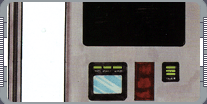 The fictional models are made of an embedded circuit composite material. All the primary electronics,
including the multilayer display screen, are bonded to the boronite whisker epoxy casing. The PADD has
three replaceable components: a subspace transceiver assembly, an isolinear memory chip, and a sarium
power loop. (You can learn more about the PADD's technical specifications in the 'Star Trek: The Next
Generation Technical Manual.') In reality, most PADDs are made out of plastic. After the master has
been produced, a rubber mold is made so that identical props can then be cast in a polyurethane resin.
These are painted and detailed by the talented workers in the Star Trek Art Department. The main body
colors used include gray, metallic gray, red, light blue, and black.
The fictional models are made of an embedded circuit composite material. All the primary electronics,
including the multilayer display screen, are bonded to the boronite whisker epoxy casing. The PADD has
three replaceable components: a subspace transceiver assembly, an isolinear memory chip, and a sarium
power loop. (You can learn more about the PADD's technical specifications in the 'Star Trek: The Next
Generation Technical Manual.') In reality, most PADDs are made out of plastic. After the master has
been produced, a rubber mold is made so that identical props can then be cast in a polyurethane resin.
These are painted and detailed by the talented workers in the Star Trek Art Department. The main body
colors used include gray, metallic gray, red, light blue, and black.
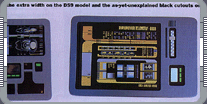 PADDs vary in size. The most commonly seen props are the standard 4" x 6" and 6" x 9" (the latter being
almost exclusively used on DS9). Some are even larger, depending on what type of hand prop the script
demands. The larger PADDs are often used to display star charts, maps, blueprints, and other large
visuals. Several of the props made for Star Trek: Insurrection measured up to 16" x 20". On some units,
the post-production special-effects team places an animated image on the display screen.
PADDs vary in size. The most commonly seen props are the standard 4" x 6" and 6" x 9" (the latter being
almost exclusively used on DS9). Some are even larger, depending on what type of hand prop the script
demands. The larger PADDs are often used to display star charts, maps, blueprints, and other large
visuals. Several of the props made for Star Trek: Insurrection measured up to 16" x 20". On some units,
the post-production special-effects team places an animated image on the display screen.
There have been a number of different configurations for the Federation PADD, some standard and some
customized by the user. On each, however, certain elements remain consistant, including a display
screen, a user interface, and some kind of status indicator. One of the most recognizable custom
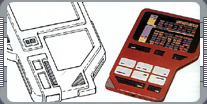 configuration is the red engineering PADD used by Geordi La Forge in the Sixth and Seventh Seasons of
TNG. The version in Season Six was a standard 4" x 6" PADD with a large additional window cut out of the
lower half of the faceplate. Within this window, six large buttons were affixed; this was uncommon for
Star Trek, since almost every other control surface is touch-sensitive. Most likely, this PADD's
appearance was due to the request of a director, producer, or someone on the production staff who wanted
a distinctive look to that particular prop. This is often the case in the birth of new configurations,
modifications, and paint schemes.
configuration is the red engineering PADD used by Geordi La Forge in the Sixth and Seventh Seasons of
TNG. The version in Season Six was a standard 4" x 6" PADD with a large additional window cut out of the
lower half of the faceplate. Within this window, six large buttons were affixed; this was uncommon for
Star Trek, since almost every other control surface is touch-sensitive. Most likely, this PADD's
appearance was due to the request of a director, producer, or someone on the production staff who wanted
a distinctive look to that particular prop. This is often the case in the birth of new configurations,
modifications, and paint schemes.
Two different Star Trek: First Contact PADDs are such examples. When First Contact went into production,
the designers did not want to borrow props from DS9 or Voyager; they wanted the new
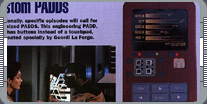 USS Enterprise NCC-1701-E to have its own look (though some
may say that Voyager would have had current technology.) In dicussing possible PADD designs, the
aforementioned custom engineering PADD became the favorite. Of course, some changes had to be made. The
visible circuit pattern in the two small windows below the display screen would now be replaced with the
standard silver button and green simulated lights, as on all 4" x 6" models. The other change was that
the gray buttons were replaced by "okudagram" graphic buttons, as on most other Starfleet control
surfaces. This gave the nine-year old PADD a new yet familiar look. The other example is that of
'borrowed technology.' John Dwyer, the set decorator for First Contact, saw a photo of a Cardassian PADD
that was part of a sample pack/bid, and requested two to be built. When the question of the Cardassian
presence in the movie was brought up, it was decided that the PADD
USS Enterprise NCC-1701-E to have its own look (though some
may say that Voyager would have had current technology.) In dicussing possible PADD designs, the
aforementioned custom engineering PADD became the favorite. Of course, some changes had to be made. The
visible circuit pattern in the two small windows below the display screen would now be replaced with the
standard silver button and green simulated lights, as on all 4" x 6" models. The other change was that
the gray buttons were replaced by "okudagram" graphic buttons, as on most other Starfleet control
surfaces. This gave the nine-year old PADD a new yet familiar look. The other example is that of
'borrowed technology.' John Dwyer, the set decorator for First Contact, saw a photo of a Cardassian PADD
that was part of a sample pack/bid, and requested two to be built. When the question of the Cardassian
presence in the movie was brought up, it was decided that the PADD
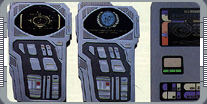 should be made to look 'Starfleet.' Painted silver and dark gray, and adorned with Starfleet emblems and
graphics, the hybrid was born. One of these was placed in the captain's ready room, which unfortunately
we never got to see much of. A replica of this version can be seen at Star Trek: The Experience exhibit
in Las Vegas. The only other connection to TNG that this PADD may have is to the engineering PADD from
Season Seven. Rarely seen, this red model used by La Forge also has the angular features of the
Cardassian PADD. The PADDs used on Voyager are again unique. Slightly thinner than the ones used on TNG,
their top and bottom edges are on a slight arc, giving the unit an almost oval shape. There are cutouts
on each side of the lower portion of the faceplate, but the function of these has not been revealed.
should be made to look 'Starfleet.' Painted silver and dark gray, and adorned with Starfleet emblems and
graphics, the hybrid was born. One of these was placed in the captain's ready room, which unfortunately
we never got to see much of. A replica of this version can be seen at Star Trek: The Experience exhibit
in Las Vegas. The only other connection to TNG that this PADD may have is to the engineering PADD from
Season Seven. Rarely seen, this red model used by La Forge also has the angular features of the
Cardassian PADD. The PADDs used on Voyager are again unique. Slightly thinner than the ones used on TNG,
their top and bottom edges are on a slight arc, giving the unit an almost oval shape. There are cutouts
on each side of the lower portion of the faceplate, but the function of these has not been revealed.
 Almost every technologically advanced race seen in Star Trek has its own version of this versatile piece
of equipment. Each has its own distinctive appearance, from the clean, simple look of the Klingon PADD
to the more complex Cardassian PADD. There are bound to be many more versions than those discussed here
(especially the custom-configured models) to keep us 'prop geeks' pausing our video tapes for a closer
look, and as Star Trek continues, there will doubtless be countless more PADDs, each a little different
from the last.
Almost every technologically advanced race seen in Star Trek has its own version of this versatile piece
of equipment. Each has its own distinctive appearance, from the clean, simple look of the Klingon PADD
to the more complex Cardassian PADD. There are bound to be many more versions than those discussed here
(especially the custom-configured models) to keep us 'prop geeks' pausing our video tapes for a closer
look, and as Star Trek continues, there will doubtless be countless more PADDs, each a little different
from the last.
|
|
"MAKING PADDS" - JULY 1999 ISSUE 3 STAR TREK: THE MAGAZINE COPYRIGHT OF PARAMOUNT PICTURES.
|